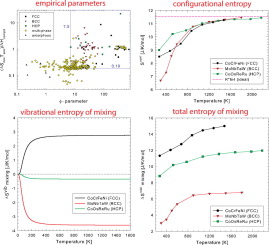Current Opinion in Solid State & Materials Science ( IF 12.2 ) Pub Date : 2017-10-12 , DOI: 10.1016/j.cossms.2017.08.001 M.C. Gao , C. Zhang , P. Gao , F. Zhang , L.Z. Ouyang , M. Widom , J.A. Hawk

|
This paper reviews the three main approaches for predicting the formation of concentrated solid solution alloys (CSSA) and for modeling their thermodynamic properties, in particular, utilizing the methodologies of empirical thermo-physical parameters, CALPHAD method, and first-principles calculations combined with hybrid Monte Carlo/Molecular Dynamics (MC/MD) simulations. In order to speed up CSSA development, a variety of empirical parameters based on Hume-Rothery rules have been developed. Herein, these parameters have been systematically and critically evaluated for their efficiency in predicting solid solution formation. The phase stability of representative CSSA systems is then illustrated from the perspectives of phase diagrams and nucleation driving force plots of the σ phase using CALPHAD method. The temperature-dependent total entropies of the FCC, BCC, HCP, and σ phases in equimolar compositions of various systems are presented next, followed by the thermodynamic properties of mixing of the BCC phase in Al-containing and Ti-containing refractory metal systems. First-principles calculations on model FCC, BCC and HCP CSSA reveal the presence of both positive and negative vibrational entropies of mixing, while the calculated electronic entropies of mixing are negligible. Temperature dependent configurational entropy is determined from the atomic structures obtained from MC/MD simulations. Current status and challenges in using these methodologies as they pertain to thermodynamic property analysis and CSSA design are discussed.
中文翻译:

浓固溶合金的热力学
本文回顾了预测固溶合金形成和热力学特性建模的三种主要方法,特别是利用经验热物理参数方法,CALPHAD方法和第一性原理计算与混合方法相结合的方法。蒙特卡洛/分子动力学(MC / MD)模拟。为了加快CSSA的开发,已经开发了基于休ume-罗西规则的各种经验参数。在本文中,已经对这些参数在预测固溶体形成方面的效率进行了系统和严格的评估。然后使用CALPHAD方法从σ相的相图和成核驱动力图的角度说明代表性CSSA系统的相稳定性。接下来介绍各种系统等摩尔成分中FCC,BCC,HCP和σ相的温度依赖性总熵,然后介绍BCC相在含铝和含钛的难熔金属系统中混合的热力学性质。对FCC,BCC和HCP CSSA模型的第一性原理计算表明,存在正,负混合振动熵,而计算出的混合电子熵可以忽略不计。由MC / MD模拟获得的原子结构确定了与温度相关的构型熵。讨论了与热力学特性分析和CSSA设计有关的使用这些方法的现状和挑战。其次是BCC相在含铝和含钛的难熔金属体系中混合的热力学性质。对FCC,BCC和HCP CSSA模型的第一性原理计算表明,存在正,负混合振动熵,而计算出的混合电子熵可以忽略不计。由MC / MD模拟获得的原子结构确定了与温度相关的构型熵。讨论了与热力学特性分析和CSSA设计有关的使用这些方法的现状和挑战。其次是BCC相在含铝和含钛的难熔金属体系中混合的热力学性质。对FCC,BCC和HCP CSSA模型的第一性原理计算表明,存在正,负混合振动熵,而计算出的混合电子熵可以忽略不计。由MC / MD模拟获得的原子结构确定了与温度相关的构型熵。讨论了与热力学特性分析和CSSA设计有关的使用这些方法的现状和挑战。而计算的混合电子熵可以忽略不计。由MC / MD模拟获得的原子结构确定了与温度相关的构型熵。讨论了与热力学特性分析和CSSA设计有关的使用这些方法的现状和挑战。而计算的混合电子熵可以忽略不计。由MC / MD模拟获得的原子结构确定了与温度相关的构型熵。讨论了与热力学特性分析和CSSA设计有关的使用这些方法的现状和挑战。











































 京公网安备 11010802027423号
京公网安备 11010802027423号